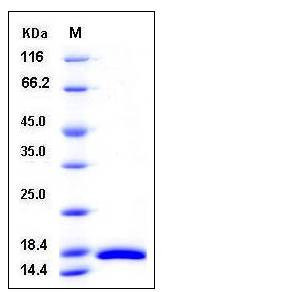Mouse CRABP2 / CRABPII Protein (His Tag)
AI893628,Crabp-2,CrabpII
- 100ug (NPP3275) Please inquiry
| Catalog Number | P50535-M07E |
|---|---|
| Organism Species | Mouse |
| Host | E. coli |
| Synonyms | AI893628,Crabp-2,CrabpII |
| Molecular Weight | The recombinant mouse CRABP2 consisting of 148 amino acids and has a calculated molecular mass of 17.1 kDa. rm CRABP2 migrates as an approximately 18 kDa band in SDS-PAGE under reducing conditions. |
| predicted N | Met |
| SDS-PAGE |  |
| Purity | > 96 % as determined by SDS-PAGE |
| Protein Construction | A DNA sequence encoding the mouse CRABP2 (P22935) (Pro 2-Glu 138) was expressed, with a polyhistide tag at the N-terminus. |
| Bio-activity | |
| Research Area | Cancer |Signal transduction |Nuclear signaling |Nuclear hormone receptors |Retinoic & Retinoid |
| Formulation | Lyophilized from sterile PBS, pH 7.4 1. Normally 5 % - 8 % trehalose, mannitol and 0.01% Tween80 are added as protectants before lyophilization. Specific concentrations are included in the hardcopy of COA. |
| Background | Mouse cellular retinoic acid-binding protein 2, also known as Cellular retinoic acid-binding protein II, CRABP-II and CRABP2, is a protein which belongs to the calycin superfamily and Fatty-acid binding protein (FABP) family. Cellular retinoic acid binding proteins (CRABP) are low molecular weight proteins whose precise function remains unknown. The predicted amino acid sequences of human CRABP1 and CRABP2 demonstrated a 99.3% and 93.5% identity to mouse CRABP1 and CRABP2, respectively. CRABP2 forms a beta-barrel structure that accommodates hydrophobic ligands in its interior. Expression of CRABP2, but not CRABP1 mRNA, was markedly increased (greater than 15-fold) by retinoic acid treatment of fibroblasts cultured from human skin, whereas no significant induction of CRABP2 mRNA was observed in human lung fibroblasts. CRABP2 transports retinoic acid to the nucleus. It regulates the access of retinoic acid to the nuclear retinoic acid receptors. CRABP2 is necessary for elastin induction by All-trans retinoic acid (ATRA) in MRC-5 cells. It is expressed at low levels in emphysema fibroblasts. This alteration in the retinoic acid signalling pathway in lung fibroblasts may contribute to the defect of alveolar repair in human pulmonary emphysema. |
| Reference |
